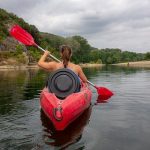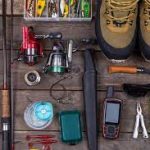The gear you use for kayaking can have a big impact on how much you enjoy the experience. Moving easily and freely is determined by how well your gear fits, which is why it’s important to choose gear that works for you.
Some equipment, like personal flotation devices, are particularly important to get right.
Many manufacturers now make gear specifically for women, which takes into account design, color, and most importantly, fit.
Here’s a look at some of the most important kayaking gear and what you need to know to make the right choices.
Choosing the Right Kayaking Equipment
Paddle
The two most common types of kayak paddles are European-style paddles and Greenland styles paddles. To become a kayaker, you must first have a kayak.
However, once you do have a kayak, you will also need the means to propel it. Therefore, you should be aware that the two most common types of kayak paddles are European-style paddles and Greenland styles paddles.
Some more experienced kayakers prefer Greenland-style paddles because they can be used for different things, but most beginner kayakers prefer European-style paddles.
Choose a paddle that is the right length for your height and the width of your kayak. Paddling with a paddle that is too short or too long will make your adventures less enjoyable. You can read more about choosing the right paddle in our guide.
Choose construction materials, a paddle shaft, and paddle blades that are best suited for the type of paddling you intend to do.
Personal Flotation Device
It is very important to have a flotation device (PFD, also known as a lifejacket) when you are on the water. A good PFD will provide enough flotation, fit properly, and be comfortable so that you will never want to take it off when you are on the water.
Look for a PFD that is approved by the Coast Guard to make sure it meets high safety standards.
When choosing a lifejacket for paddling, you should look for one that is designed specifically for that purpose.
These lifejackets will have less bulk around the shoulders, bigger arm holes to allow a full range of motion, and a shorter torso for comfort when sitting in a kayak.
Paddling-specific PFDs also have useful features like pockets to store sunscreen, snacks, and lip balm, and some even have a place for a water bladder to make it easier to drink frequently on longer outings.
Some personal floatation devices (PFDs) are too bulky to be comfortable when sitting in high-backed kayak seats. Another option is to get a lifejacket that is designed with the lower half of the back as thin mesh so there’s no bulk between your back and the back of the seat.
When you are shopping for a personal flotation device, it is important to try on many different types and designs, both for men and women, in order to find the one that feels best to you.
Once you have found a design that you like, sit in a kayak that is the same model or very similar to the one you will be using, in order to ensure that the PFD will be comfortable when you are actually in your boat.
To make sure the life jacket fits properly, tighten all the straps and make sure it doesn’t come up past your ribs.
It is important to always wear your life jacket when on the water, even if the water is calm. If you don’t wear your life jacket and keep it in the boat, it will not be of any help if you end up in the water. A poorly worn life jacket can also make it difficult to swim to shore. For your safety, make sure to wear and use your life jacket properly.
Spray Skirts
A spray skirt is a type of accessory that is worn by people who go kayaking. It is designed to keep water out of the kayak and also to provide sun and wind protection for the legs.
Spray skirts can also help to retain body heat in the cockpit and keep the bottom half of the body warmer. They are worn under the PFD and they slip on like a skirt. The hem of the spray skirt attaches to the rim of the cockpit.
All spray skirts have a grab loop or ripcord at the front which, when pulled toward the kayaker, releases the skirt from the cockpit and allows the kayaker to exit the boat.
Select a spray skirt made from nylon or neoprene depending on the conditions you’ll be paddling in. If you’re mostly concerned with sun and wind protection while paddling on flat water, a nylon skirt will offer more ventilation.
However, keep in mind that it won’t be as waterproof as a neoprene skirt. If you’re planning on paddling in rougher water or colder weather, go with a neoprene skirt for better protection from the elements.
You can also find hybrid skirts made with neoprene on the bottom and nylon on the top. These are good for in-between conditions, but won’t provide enough protection in extreme conditions.
Footwear
The best footwear for kayaking is something that dries quickly and protects your feet. I recommend something with a thick sole and good tread to protect your feet and keep you from slipping on wet rocks.
It is advisable to bring along a pair of sandals if you would rather go kayaking without shoes, so that you can slip them on when you reach land. In colder weather, wearing socks made from fleece, wool, or neoprene underneath your water shoes will help keep your feet warm. Neoprene socks are most effective at insulating when wet, followed by wool and then fleece.
Clothing
Clothing for paddling should be made of materials that won’t absorb water, will wick moisture away from your skin, and won’t weigh you down if you happen to fall in the water.
Paddling clothing for women has come a very long way and there are wonderful designs, colors, and materials to choose from. It’s worth investing in good quality clothing that fits well, is comfortable, and lasts a long time.
You should always dress for the temperature of the water as well as the outside temperature to stay safe. Being prepared for the worst-case scenario is key. If you falls into the water, it might take some time to get back into your boat. So, you should be dressed to spend some time immersed in the water, even if it’s hot outside.
It’s important to never wear cotton when you’re paddling, especially in colder conditions. Wet cotton draws heat away from your body, which can cause hypothermia.
Paddle Float
If you accidentally capsize and are unable to roll back upright again, you will need a way to get back into your kayak. A paddle float is a self-rescue device that can be attached to a paddle blade to create an outrigger. This will allow you to get back into your kayak after a wet exit.
With a paddle float on your kayak, you can easily get back in your kayak if you fall out.
Bilge Pump
. If you accidentally capsize and have to get out of your kayak, when you turn it over again, water will fill the cockpit. So, in addition to a paddle float to help you get back in, you need a way to pump the water out of the cockpit once you’re back in.
While those who paddle sit-on-top kayaks do not have to worry about draining the water from their kayak, those who paddle sit-inside kayaks do have to worry about it.
To avoid this problem, all those who paddle sit-inside kayaks should install a bulkhead-mounted foot pump or a hand-operated deck pump, or purchase a hand-operated bilge pump to carry with them on their kayak.
GPS Receiver
When paddling on unfamiliar waters, it can be difficult to find your way back to your original launch point. Fortunately, there are Global Positioning Satellites that can help you.
A GPS receiver can show you the route you took and save it so you can find your way back. Many people buy one for kayaking trips so they can worry less about getting lost.
CB/VHS Radio
If you get lost or have an emergency while boating, it can be very helpful to have a way to contact and talk to other boaters and/or rescue workers in your area.
Your cell phone might not always work on the water or in the wilderness areas of some waterways, so many kayakers carry a handheld Citizens Band radio (also called a CB) or a Very High-Frequency radio (also called a VHF) with them while paddling.
Paddlers should be aware that while neither CB or VHS radios require a license to operate them, many countries consider it illegal to use a VHS radio while paddling on inland waters.
A good rule of thumb is to use a CB radio when paddling in freshwater, and a VHS radio when paddling in saltwater.
PLB Transmitter
If you’re paddling and can’t get in touch with anyone via CB or VHS radio in an emergency, you should also have a Personal Locator Beacon with you. PLBs are one-way devices that send an emergency locator signal so rescue personnel can find you.
Therefore, simply by deploying the transmitter’s antenna and then pressing two buttons simultaneously, PLBs are designed to emit an electronic emergency beacon which is then transmitted to a series of search and rescue satellites that orbit the earth.
The satellites then relay that beacon to the nearest emergency rescue personnel office.
There are two types of PLBs- those that only transmit an emergency beacon with a general location, and those that are designed to transmit longitude and latitude to within a couple of feet. The latter type is more accurate and beneficial for rescue personnel.




